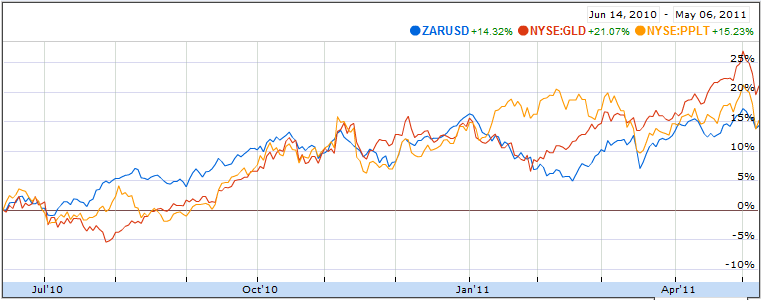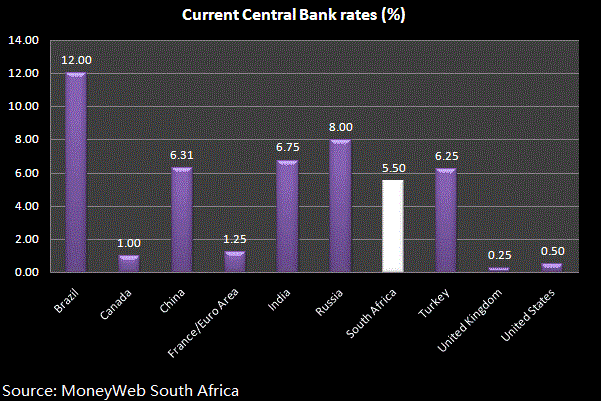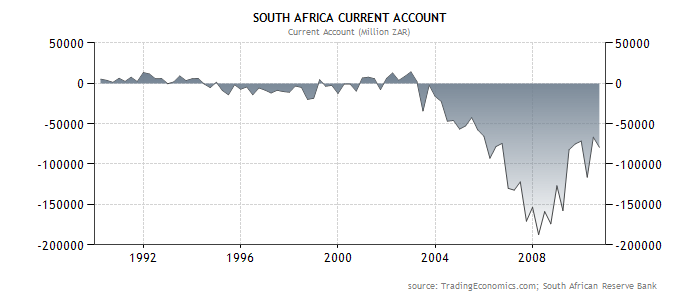Forex Blog |
| Posted: 07 May 2011 09:28 AM PDT The story of the South African Rand (ZAR) is nearly identical to that of other leading emerging market currencies: multi-year gains were completely undone by the 2008 credit crisis, only to be restored in 2009 and 2010. From trough to peak, the Rand has now risen 64%, including 15% over the last twelve months and 10% over the last six weeks. While the reasons for its renewal are understandable, they are far from justifiable. Based on a number of metrics, the Rand now appears to be somewhat overvalued. Just like its BRIC (which it was recently invited to join) peers, the Rand’s appeal lies in high growth prospects and even higher nominal interest rates. It has also been bought amidst the general pickup in risk appetite (complacency) that has spurred investors back into emerging markets. Given the relatively small size of its economy and proportionately small money supply, it’s no surprise that demand for Rand – made worse by the difficulty of betting directly on China - has overwhelmed the supply. Despite repeated cuts, South Africa’s benchmark interest rate still stands at a lofty 5.5%. Relative price stability also means that interest rates are positive in real terms, a claim which few countries can make nowadays. Thanks to bond yields hovering around 8% and a comparatively modest government debt, lending to South Africa still carries a significant risk-adjusted return advantage over other emerging markets. The Bank of South Africa is trying to hold off on hiking rates for as long as possible, partly to avoid stimulating the Rand. Its decision to tighten will essentially be determined by the battle between unemployment and inflation. With more than 25% of South Africans out of work, the Bank is understandably reluctant to take any steps that would ameliorate that problem. Perhaps above all else, the Rand’s rise has been closely correlated with the ongoing commodities boom. South Africa is the world’s largest producer of platinum and palladium, second largest of gold, and at the top of the rankings for a handful of other precious metals and minerals. Thus, you can see from the chart below that the Rand/Dollar rate has very closely tracked platinum and gold prices for the last twelve months. Aside from a modest correction (induced by a temporary ebb in risk aversion) at the end of 2010, the three assets appear to have moved in lockstep!  While rising commodities prices have certainly been a boon to South Africa’s foreign exchange reserves, it hasn’t done much for its economy. In fact, mining comprises only 3% of South Africa’s economy (down from 14% two decades ago), and analysts expect that this proportion will decline further as deposits are mined to exhaustion. Its balance of trade fluctuates between surplus and deficit, as revenues from increased commodities exports are turned around and spent on imports. (China is now South Africa’s largest trading partner). Still, given the record current account deficits of the last few years, foreign investors evidently are undeterred from bridging the South African shortfall in domestic investment, even (or especially!) at current exchange rates. Going forward, there are plenty of analysts that believe the Rand will continue rising, at a healthy rate of around 10% per year. This notion is based as much on the depreciation of major currencies - which were punished for their respective Central Banks’ expansionary monetary policies - as it is in the appreciation of the Rand. In fact, the Rand’s performance against a basket of emerging market currencies has been more modest; on a trade-weighted basis, it has still risen an estimated 15% since 1995. Regardless, this suggests that any bubble underlying the Rand is no different from that which may affect any number of other currencies. Still, it’s hard to argue with fundamentals. According to one back-of-the-envelope analysis based on purchasing power parity (ppp) differentials, the Rand will need to depreciate significantly if it is to return to more normalized valuation levels. “Since 2000, South African inflation has exceeded that of the US by 44 percent, while the rand has depreciated by just over 10 percent, which means that goods in South Africa are now over 30 percent more expensive for Americans than they were a decade ago… it is impossible to know when this difference will unwind, but…it is reasonable to assume that it will unwind in every five-year period, and this would entail a depreciation in the rand-US dollar exchange rate of six percent a year.” Reasonable indeed. Ultimately, it is going to be tough to sell this argument to carry traders, who care more about interest rate differentials than inflation differentials, which means the Rand could continue to rise over the short-term. Over the medium-term, however, the Bank of South Africa may see to it that this trend does not continue.  |
| You are subscribed to email updates from Forex Blog To stop receiving these emails, you may unsubscribe now. | Email delivery powered by Google |
| Google Inc., 20 West Kinzie, Chicago IL USA 60610 | |









0 comments:
Post a Comment